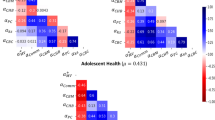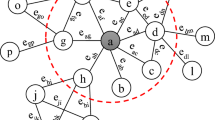Abstract
A leader in a network plays important roles for various services of the network and controls problems of the network. Therefore, when the nodes with high centrality are selected as the leader nodes in the network, the network can be more efficiently controlled, and the amount of wasted resources can be reduced. In this study, we propose a novel method for determining leader nodes by measuring centrality of nodes in the ad hoc networks. The proposed method can obtain the centrality of each node using the average depth of nodes based on the tree topology. Consequently, the amount of the information required for leader election becomes smaller and the calculation process is also simpler, compared with those of representative centrality methods in social network analysis (SNA). In the experiment, the proposed tree-based centrality technique is compared with the well-known centrality schemes such as degree, closeness, and betweenness. The proposed tree-based centrality method has similar centrality priority as degree, closeness, and betweenness and also has better performance in the comparison of the control messages generated.
Similar content being viewed by others
References
Corson, S., & Macker, J. (1999). Mobile ad hoc networking (MANET): routing protocol performance. In IETF RFC 2501, January 1999.
Perkins, C. E. (2000). Ad hoc networking. Reading: Addison-Wesley.
IETF MANET Working Group (2004). http://www.ietf.org/html.charters/manet-charter.html.
Perkins, C., & Bhagwat, P. (1994). Highly dynamic destination-sequenced distance-vector routing (DSDV) for mobile computers. In Proceedings of ACM SIGMOMM.
Clausen, T., & Jacquet, P. (2003). Optimized link state routing protocol (OLSR). In IETF RFC3626, October 2003.
Ogier, R. G., Lewis, M. G., & Templin, F. L. (2004). Topology broadcast based on reverse-path forwarding. In IETF RFC3684, February 2004.
Das, S., Perkins, C., & Royer, E. (2003). Ad Hoc on demand distance vector (AODV) routing. In IETF RFC3561, July 2003.
Kim, C., Talipov, E., & Ahn, B. (2006). A reverse AODV routing protocol in ad hoc mobile networks. In LNCS: Vol. 4097. EUC workshops 2006 (pp. 522–531).
Vasudevan, S., Kurose, J., & Towsley, D. (2004). Design and analysis of a leader election algorithm for mobile ad hoc networks. In Proceedings of the 12th IEEE international conference on network protocols (ICNP’04), Berlin, Germany (pp. 350–360). Los Alamitos: IEEE Computer Society.
Malpani, N., Welch, J., & Waidya, N. (2000). Leader election algorithms for mobile ad hoc networks. In Proceedings of 4th international workshop on discrete algorithms and methods for mobile computing and communications (pp. 93–103). New York: ACM.
Gallager, R. G., Humblet, P. A., & Spira, P. M. (1983). A distributed algorithm for minimum weight spanning trees. ACM Transactions on Programming Languages and Systems, 5(1), 66–77.
Peleg, D. (1990). Time optimal leader election in general networks. Journal of Parallel and Distributed Computing, 8(1), 96–99.
Janson, S., Lavault, C., & Louchard, G. (2008). Convergence of some leader election algorithms. Discrete Mathematics and Theoretical Computer Science, 10(3), 171–196.
Vasudevan, S., Kurose, J., & Towsley, D. (2004). Design of a leader election protocol in mobile ad hoc distributed systems. In Proceedings of the 12th IEEE international conference on network protocols (pp. 350–360).
Zhang, G., Kuang, X., Chen, J., & Zhang, Y. (2009). Design and implementation of a leader election algorithm in hierarchy mobile ad hoc network. In Proceedings of the 4th international conference on computer science & education.
Lee, S., Muhammad, R., & Kim, C. (2007). A leader election algorithm within candidates on ad hoc mobile networks. In LNCS: Vol. 4523. Proceedings of the international conference on embedded software and systems (ICESS-07).
Gupta, S., & Srimani, P. (2001). Core-based tree with forwarding regions(CBT-FR); a protocol for reliable multicasting in mobile ad hoc networks. Journal of Parallel and Distributed Computing, 61, 1249–1277.
DeCleene, B., Dondeti, L., Griffin, S., Hardjono, T., Kiwior, D., Kurose, J., Towsley, D., Vasudevan, S., & Zhang, C. (2001). Secure group communication for wireless networks. In Proceedings of the IEEE military communications conference (MILCOM 2001) (pp. 113–117).
Sundararaman, B., Buy, U., & Kshemkalyani, A. (2005). Clock synchronization for wireless sensor networks: a survey. Ad Hoc Networks, 3(3), 281–323.
Blazevic, L., Boudec, J., & Giordano, S. (2005). A location-based routing method for mobile ad hoc networks. IEEE Transactions On Mobile Computing, 4(2), 97–110.
Bayazit, O. B., Lien, J. M., & Amato, N. M. (2002). Better group behaviors in complex environments using global roadmaps. In Proceedings of 8th international conference on the simulation and synthesis of living systems (Alife’02) (pp. 362–370). Cambridge: MIT Press.
Freeman, L. C. (1978/1979). Centrality in social networks conceptual clarification. Social Networks, 1, 215–239.
Newman, M. E. J. (2005). A measure of betweenness centrality based on random walks. Social Networks, 27(1), 39–54.
Kleinberg, J. M. (1999). Authoritative sources in a hyperlinked environment. Journal of the ACM, 46(5), 604–632.
Jung, J. J. (2008). Ontology-based context synchronization for ad-hoc social collaborations. Knowledge-Based Systems, 21(7), 573–580.
Jung, J. J. (2008). Query transformation based on semantic centrality in semantic social network. Journal of Universal Computer Science, 14(7), 1031–1047.
Jung, J. J. (2009). Contextualized mobile recommendation service based on interactive social network discovered from mobile users. Expert Systems with Applications, 36(9), 11950–11956.
Wu, M., Kim, C., & Jung, J.J. (2010). Leader election based on centrality and connectivity measurements in ad hoc networks. In LNCS: Vol. 6070. Proceedings of the 4th KES international symposium on agent and multi-agent systems: technologies and applications (KES-AMSTA) (pp. 401–410).
Borgatti, S. P., Everett, M. G., & Freeman, L. C. (2002). UCINET for windows: software for social network analysis. Harvard: Analytic Technologies.
Enriquez, J. G. (2010). Fluid centrality: a social network analysis of social-technical relations in computer-mediated communication. International Journal of Research & Method in Education, 33(1), 55–67.
Wu, M., Kim, S. H., & Kim, C. (2010). A routing method based in cost matrix in ad hoc networks. In 2nd Asian conference on intelligent information and database systems, Hue city, Vietnam, 24–26 (pp. 337–347).
Wu, M., & Kim, C. (2010). A cost matrix agent for shortest path routing in ad hoc networks. Journal of Network and Computer Applications, 33, 646–652.
Author information
Authors and Affiliations
Corresponding author
Rights and permissions
About this article
Cite this article
Kim, C., Wu, M. Leader election on tree-based centrality in ad hoc networks. Telecommun Syst 52, 661–670 (2013). https://doi.org/10.1007/s11235-011-9510-8
Published:
Issue Date:
DOI: https://doi.org/10.1007/s11235-011-9510-8




